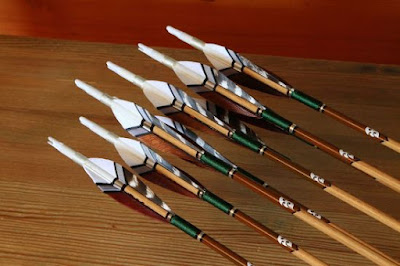The following glossary is not comprehensive. Indeed there are many more types of arrowheads, fletches, shafts and specialty nocks used for arrows that aren't listed here. Eg. Lighted LED nocks.
Arrow: A projectile used with a bow, consisting of a shaft with a pointed tip on one end and stabilizing feathers or vanes on the other.
Blunt Point or Bludgeon Point: A rounded or flat tip designed for hunting small game or birds. Blunt points will still kill a small target through blunt force.
Bodkin Point: A type of arrowhead characterized by a narrow, pointed tip. Bodkin points were historically used to penetrate armor or thick hides.
Broadhead: An arrowhead with wide blades designed for hunting. Broadheads have sharp cutting edges that cause significant damage to the target upon impact. They come in various designs, including fixed-blade and expandable-blade types.
Cock Fletch/Vane: Also known as the Rooster or Index fletch, it is a fletching that is coloured differently from the others to indicate the correct orientation when nocking the arrow.
Cresting: Decorative markings or designs applied to the shaft of an arrow. Cresting is often used for identification or aesthetic purposes.
Cresting Paint: Specialized paint used to apply decorative markings, designs, or patterns on the arrow shaft. Cresting paint is often durable and resistant to wear and tear.
Cresting Wheel: A rotating device used to apply cresting paint to the arrow shaft. The wheel allows for precise and consistent application of markings or designs.
Feather: Traditionally, arrows were fletched with feathers, usually from birds like turkeys. Feathers provide stability and can be either natural or synthetic.
Field Point: Also known as a bullet point or practice point, it is a simple conical tip used primarily for practice and target shooting. It is usually made of metal and has a smooth surface. Field points help prevent damage to targets.
Fletching: The feathers or vanes attached to the rear end of the arrow shaft, responsible for stabilizing the arrow's flight. Fletching helps to minimize drag and maintain accuracy.
Fletching Jig: A device used to position and attach fletching to arrow shafts. The jig ensures consistent placement and angles for optimal arrow flight.
Fletchings Orientation: Refers to the positioning of the feathers or vanes on an arrow shaft. The orientation can be helical (twisted) or straight, affecting arrow stability and spin.
Fletching Tape/Adhesive: The tape or adhesive used to secure the fletching to the arrow shaft. It can be in the form of double-sided tape, glue, or specialized adhesive.
Flu-Flu: A specialized type of fletching with large, full-length feathers or vanes. Flu-flu arrows are designed to slow down quickly and are easy to find, making them suitable for aerial target shooting or hunting birds in the woods. Flu Flu fletching is often brightly coloured (eg. bright yellow) in order to make them easy to find.
Insert: A component inserted into the front end of the arrow shaft, typically made of aluminum or other metal. Inserts provide a threaded connection for screw-in arrowheads and enhance durability.
Judo Point: A specialized arrowhead used for small game hunting. It features spring-loaded arms or wire prongs that prevent the arrow from burying too deep into the ground or vegetation.
Nock: A slot or groove at the rear end of the arrow, designed to engage with the bowstring, allowing the arrow to be properly positioned and released.
Nock Collar: A protective ring or sleeve placed around the rear end of the arrow shaft, near the nock. The nock collar adds strength and durability to the arrow and helps prevent damage.
Point/Tip: The front end of the arrow that pierces the target. Various types of arrowheads exist, each serving different purposes.
Screw-In Point: A type of arrowhead that can be screwed into the arrow shaft, allowing for easy replacement or customization of the point type for specific tasks.
Shaft: The main body of the arrow, typically made of materials like wood, carbon fiber, aluminum, or a combination.
Spine: The stiffness of an arrow shaft, usually measured in deflection or spine value. The spine affects how the arrow flexes during flight and interacts with the bow.
Vane: Modern arrows often use plastic vanes instead of feathers. Vanes are typically made of materials like plastic or rubber and offer improved durability and consistency.Whistling Arrowheads: Arrowheads with holes cut within them and a hollow interior that make a loud whistling noise when shot. Tibetan and Mongolian archers also used howling arrowheads / howling broadheads, which had the added benefit of demoralizing the enemy in addition to wounding/killing them.
Wrap: A decorative tape or shrinkable tube applied to the arrow shaft. Wraps can feature designs, patterns, or personalization and provide additional protection to the shaft.




No comments:
Post a Comment
Comments containing links will be marked as spam and not approved. We moderate EVERY comment. Unmoderated comments are hidden until approved.
If you want better quality advertising, consider product reviews instead.